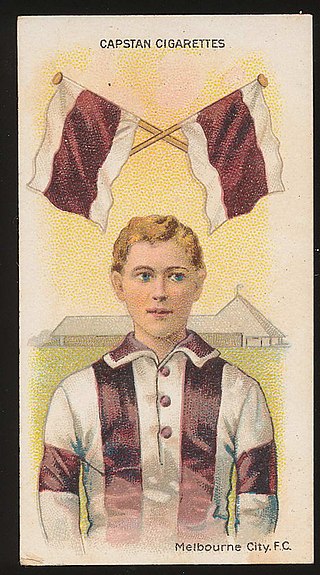
The Northern Bullants are a semi-professional Australian rules football club that currently competes in the Victorian Football League (VFL). The club, which is based in the Melbourne suburb of Preston, plays its home games at Preston City Oval.

The Yarraville Football Club, nicknamed the Eagles, was an Australian rules football club founded in 1903 which competed in the Victorian Football Association (VFA) from 1928 until the club went into recess in 1984.

Percival Henry Rowe was a player and coach in the Victorian Football League (VFL) and Victorian Football Association (VFA).

The Northcote Football Club (/ˈnoːθ.kət/), nicknamed the Dragons, was an Australian rules football club which played in the VFA from 1908 until 1987. The club's colours for most of its time in the VFA were green and yellow, and it was based in the Melbourne suburb of Northcote.

The Camberwell Football Club, nicknamed the Cobras, was an Australian rules football club based in the Melbourne suburb of Camberwell. The club competed in the Victorian Football Association (VFA) from 1926 until 1990, which was followed by three seasons in the Victorian Amateur Football Association (VAFA) before going into recess in 1995.
Daniel George Gough was an Australian rules footballer who played for Fitzroy and Carlton in the Victorian Football League (VFL).
Charles Rupert Stewart was an Australian rules football player and coach.

The Kew Football Club, nicknamed the Bears, is an Australian rules football club based in the Melbourne suburb of Kew. The club's men's team currently competes in Division 1 of the Victorian Amateur Football Association (VAFA), while the women's team is in the Premier Division of the VAFA Women's (VAFAW) competition.

Melbourne City Football Club was an Australian rules football club which played in the Victorian Football Association (VFA) in 1912 and 1913, and was notable for failing to win any matches in that time. The club played its home matches at the East Melbourne Cricket Ground.
The 1915 Victorian Football Association season was the 39th season of the Australian rules football competition.
The 1916 Victorian Football Association season was not played owing to World War I, which was at its peak at the time.
The 1924 Victorian Football Association season was the 46th season of the Australian rules football competition. The premiership was won by the Footscray Football Club, after it defeated Williamstown by 45 points in the final on 20 September. It was the club's ninth and last VFA premiership before it, along with North Melbourne and Hawthorn, joined the Victorian Football League the following year; this marked the end of a long period of dominance for Footscray, which had seen it win five minor premierships in a row and four major premierships in six years.
The 1926 Victorian Football Association season was the 48th season of the Australian rules football competition. The premiership was won by the Coburg Football Club, after it defeated Brighton by 16 points in the final on 18 September. It was the club's first VFA premiership, achieved in only its second season of senior competition.
The 1928 Victorian Football Association season was the 50th season of the Australian rules football competition. The premiership was won by the Coburg Football Club, after it defeated Port Melbourne by seven points in the final on 8 September. It was the club's third VFA premiership, achieved in only its fourth season of senior competition, and was the third in a sequence of three premierships won consecutively from 1926 until 1928.
Bill Lawry Oval, formerly known as Northcote Park, is a cricket and Australian rules football stadium located on Westgarth St, Northcote, Victoria. It is most notable as the home ground of the Northcote Cricket Club in the Victorian Premier Cricket, and of the Northcote Football Club in the Victorian Football Association (VFA).
Croxton Park was a multi-purpose sports venue located in present-day Northcote and Thornbury, Victoria. It comprised a horse racing track which was in use from 1865 until 1873, and a grassed oval used for Australian rules football and other sports until the 1910s.
The Victorian Junior Football Association (VJFA), sometimes known simply as the Victorian Junior Association (VJA), was an open age Australian rules football competition and administrative body. It was the first successful junior football competition in Melbourne, and was in existence from 1883 until 1932.
The Port Melbourne Railway United Football Club, also known simply as Railway United or just Railway, was an Australian rules football club based in Port Melbourne.

The South Melbourne Districts Football Club, nicknamed the Bloods, is an Australian rules football club based in South Melbourne. The club also has athletics and cricket programs.







